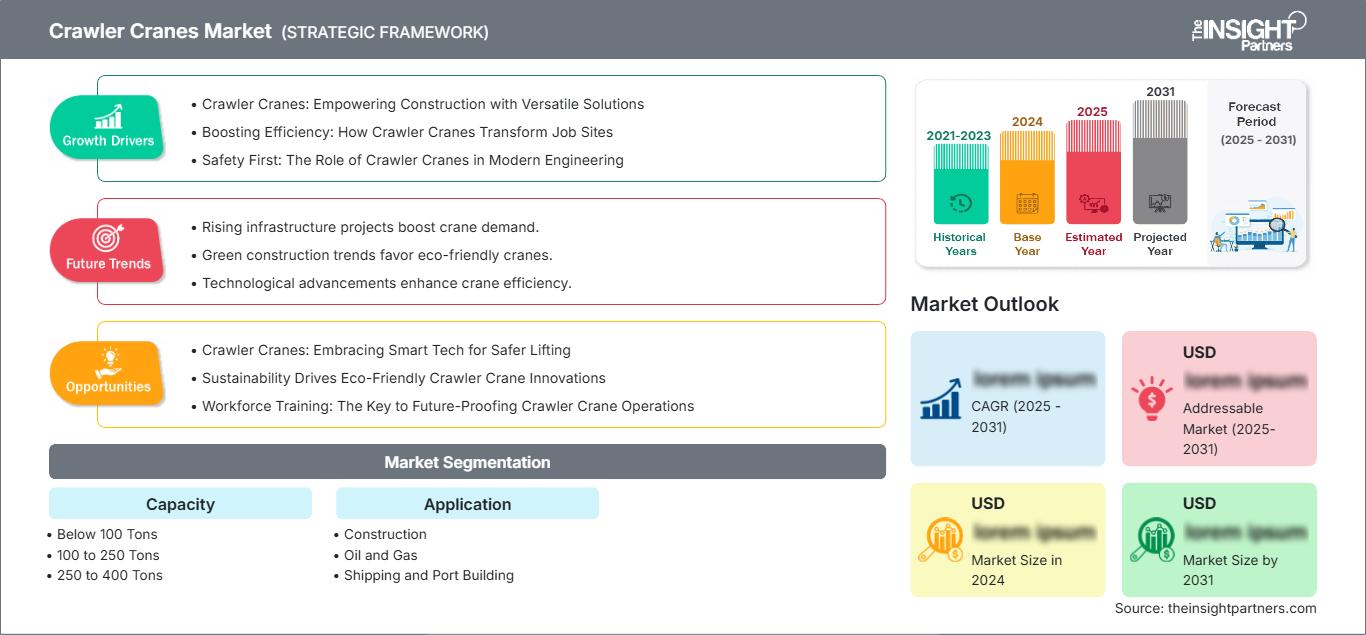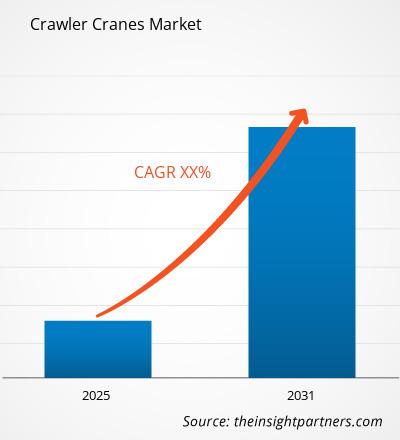Der Markt für Raupenkrane wird voraussichtlich von 2026 bis 2034 ein kontinuierliches Wachstum verzeichnen. Die Marktkapitalisierung soll gegenüber dem Basisjahr 2025 steigen und bis zum Ende des Prognosezeitraums nachhaltig wachsen. Dieser Trend spiegelt positive Marktaussichten wider, die durch sich wandelnde Branchenanforderungen und fortschreitende technologische Entwicklungen begünstigt werden.
Der Bericht ist nach Kapazität (unter 100 Tonnen, 100 bis 250 Tonnen, 250 bis 400 Tonnen, über 400 Tonnen) kategorisiert und analysiert den Markt zudem nach Anwendung (Bauwesen, Öl und Gas, Schifffahrt und Hafenbau, Energieversorgung). Für jedes dieser Schlüsselsegmente wird eine umfassende Aufschlüsselung auf globaler, regionaler und Länderebene bereitgestellt.
Der Bericht enthält Marktgrößen und Prognosen für alle Segmente, angegeben in US-Dollar. Er liefert außerdem wichtige Statistiken zum aktuellen Marktstatus führender Akteure sowie Einblicke in vorherrschende Markttrends und neue Chancen.
Zweck des Berichts
Der Bericht „Markt für Raupenkrane“ von The Insight Partners beschreibt die aktuelle Marktlage und das zukünftige Wachstum, die wichtigsten Triebkräfte, Herausforderungen und Chancen. Er bietet Einblicke für verschiedene Akteure im Markt, wie zum Beispiel:
- Technologieanbieter/Hersteller: Um die sich entwickelnde Marktdynamik zu verstehen und die potenziellen Wachstumschancen zu erkennen, damit sie fundierte strategische Entscheidungen treffen können.
- Investoren: Um eine umfassende Trendanalyse hinsichtlich der Marktwachstumsrate, der finanziellen Marktprognosen und der Chancen entlang der gesamten Wertschöpfungskette durchzuführen.
- Regulierungsbehörden: Zur Regulierung von Richtlinien und Überwachungstätigkeiten auf dem Markt mit dem Ziel, Missbrauch zu minimieren, das Vertrauen der Anleger zu erhalten und die Integrität und Stabilität des Marktes zu wahren.
Marktsegmentierung für Raupenkrane Kapazität
- Unter 100 Tonnen
- 100 bis 250 Tonnen
- 250 bis 400 Tonnen
- Über 400 Tonnen
Anwendung
- Konstruktion
- Öl und Gas
- Schifffahrts- und Hafenbau
- Energie und Versorgung
Sie erhalten eine kostenlose Anpassung aller Berichte – einschließlich Teilen dieses Berichts, Länderanalysen und Excel-Datenpaketen – sowie attraktive Angebote und Rabatte für Start-ups und Universitäten.
Markt für Raupenkrane: Strategische Einblicke

-
Ermitteln Sie die wichtigsten Markttrends dieses Berichts.Diese KOSTENLOSE Probe beinhaltet eine Datenanalyse, die von Markttrends bis hin zu Schätzungen und Prognosen reicht.
Wachstumstreiber des Raupenkranmarktes
- Raupenkrane: Vielseitige Lösungen für die Baubranche
- Effizienzsteigerung: Wie Raupenkrane Baustellen verändern
- Sicherheit geht vor: Die Rolle von Raupenkranen im modernen Maschinenbau
Markt für Raupenkrane: Zukunftstrends
- Steigende Infrastrukturprojekte erhöhen die Nachfrage nach Kranen.
- Trends im Bereich des nachhaltigen Bauens begünstigen umweltfreundliche Kräne.
- Technologische Fortschritte verbessern die Effizienz von Kranen.
Marktchancen für Raupenkrane
- Raupenkrane: Intelligente Technologie für sichereres Heben
- Nachhaltigkeit treibt Innovationen bei umweltfreundlichen Raupenkranen voran.
- Mitarbeiterschulung: Der Schlüssel zur Zukunftssicherung des Raupenkranbetriebs
Markt für Raupenkrane: Regionale Einblicke
Die regionalen Trends und Einflussfaktoren auf den Markt für Raupenkrane im gesamten Prognosezeitraum wurden von den Analysten von The Insight Partners eingehend erläutert. Dieser Abschnitt behandelt außerdem die Marktsegmente und die geografische Verteilung des Raupenkranmarktes in Nordamerika, Europa, Asien-Pazifik, dem Nahen Osten und Afrika sowie Süd- und Mittelamerika.
Marktbericht für Raupenkrane – Umfang
| Berichtattribute | Details |
|---|---|
| Marktgröße im Jahr 2025 | XX Millionen US-Dollar |
| Marktgröße bis 2034 | XX Millionen US-Dollar |
| Globale durchschnittliche jährliche Wachstumsrate (2026 - 2034) | XX% |
| Historische Daten | 2021-2024 |
| Prognosezeitraum | 2026–2034 |
| Abgedeckte Segmente |
Nach Kapazität
|
| Abgedeckte Regionen und Länder |
Nordamerika
|
| Marktführer und wichtige Unternehmensprofile |
|
Marktdichte der Raupenkrane: Auswirkungen auf die Geschäftsdynamik verstehen
Der Markt für Raupenkrane wächst rasant, angetrieben durch die steigende Nachfrage der Endkunden. Gründe hierfür sind unter anderem sich wandelnde Verbraucherpräferenzen, technologische Fortschritte und ein wachsendes Bewusstsein für die Vorteile des Produkts. Mit steigender Nachfrage erweitern Unternehmen ihr Angebot, entwickeln innovative Lösungen, um den Kundenbedürfnissen gerecht zu werden, und nutzen neue Trends, was das Marktwachstum zusätzlich beflügelt.

- Verschaffen Sie sich einen Überblick über die wichtigsten Akteure im Markt für Raupenkrane.
Wichtigste Verkaufsargumente
- Umfassende Abdeckung: Der Bericht beinhaltet eine umfassende Analyse der Produkte, Dienstleistungen, Typen und Endnutzer des Raupenkranmarktes und bietet so ein ganzheitliches Bild.
- Expertenanalyse: Der Bericht basiert auf dem fundierten Wissen von Branchenexperten und Analysten.
- Aktuelle Informationen: Der Bericht gewährleistet Geschäftsrelevanz durch die Berücksichtigung aktueller Informationen und Datentrends.
- Anpassungsmöglichkeiten: Dieser Bericht kann an die spezifischen Anforderungen des Kunden angepasst werden und sich optimal in die Geschäftsstrategien einfügen.
Der Forschungsbericht zum Markt für Raupenkrane kann daher maßgeblich dazu beitragen, das Branchenszenario und die Wachstumsaussichten zu entschlüsseln und zu verstehen. Auch wenn einige berechtigte Bedenken bestehen, überwiegen die Vorteile dieses Berichts insgesamt die Nachteile.
- Historische Analyse (2 Jahre), Basisjahr, Prognose (7 Jahre) mit CAGR
- PEST- und SWOT-Analyse
- Marktgröße Wert/Volumen – Global, Regional, Land
- Branchen- und Wettbewerbslandschaft
- Excel-Datensatz
Aktuelle Berichte
Erfahrungsberichte
Grund zum Kauf
- Fundierte Entscheidungsfindung
- Marktdynamik verstehen
- Wettbewerbsanalyse
- Kundeneinblicke
- Marktprognosen
- Risikominimierung
- Strategische Planung
- Investitionsbegründung
- Identifizierung neuer Märkte
- Verbesserung von Marketingstrategien
- Steigerung der Betriebseffizienz
- Anpassung an regulatorische Trends






















 Kostenlose Probe anfordern für - Markt für Raupenkrane
Kostenlose Probe anfordern für - Markt für Raupenkrane